Comprehensive Logistics and Supply Chain Management Report Analysis
VerifiedAdded on 2020/05/08
|9
|1968
|55
Report
AI Summary
This report provides a comprehensive analysis of Logistics and Supply Chain Management (SCM). It begins with short answer questions covering forecasting, third-party logistics (3PLs), humanitarian logistics, and the use of Information Technology (IT) such as EDI, ERP, RFID, CPFR, and VMI in SCM. The report then delves into two detailed case studies. The first case study examines IKEA's sustainable supply chain practices, emphasizing its sourcing of materials, manufacturing processes, and distribution strategies. The second case study focuses on IKEA's logistics and supply chain strategies, including its self-service model, cost-per-touch inventory management, supplier relationships, and commitment to low prices while adhering to ethical business principles. The report concludes with a list of relevant references.
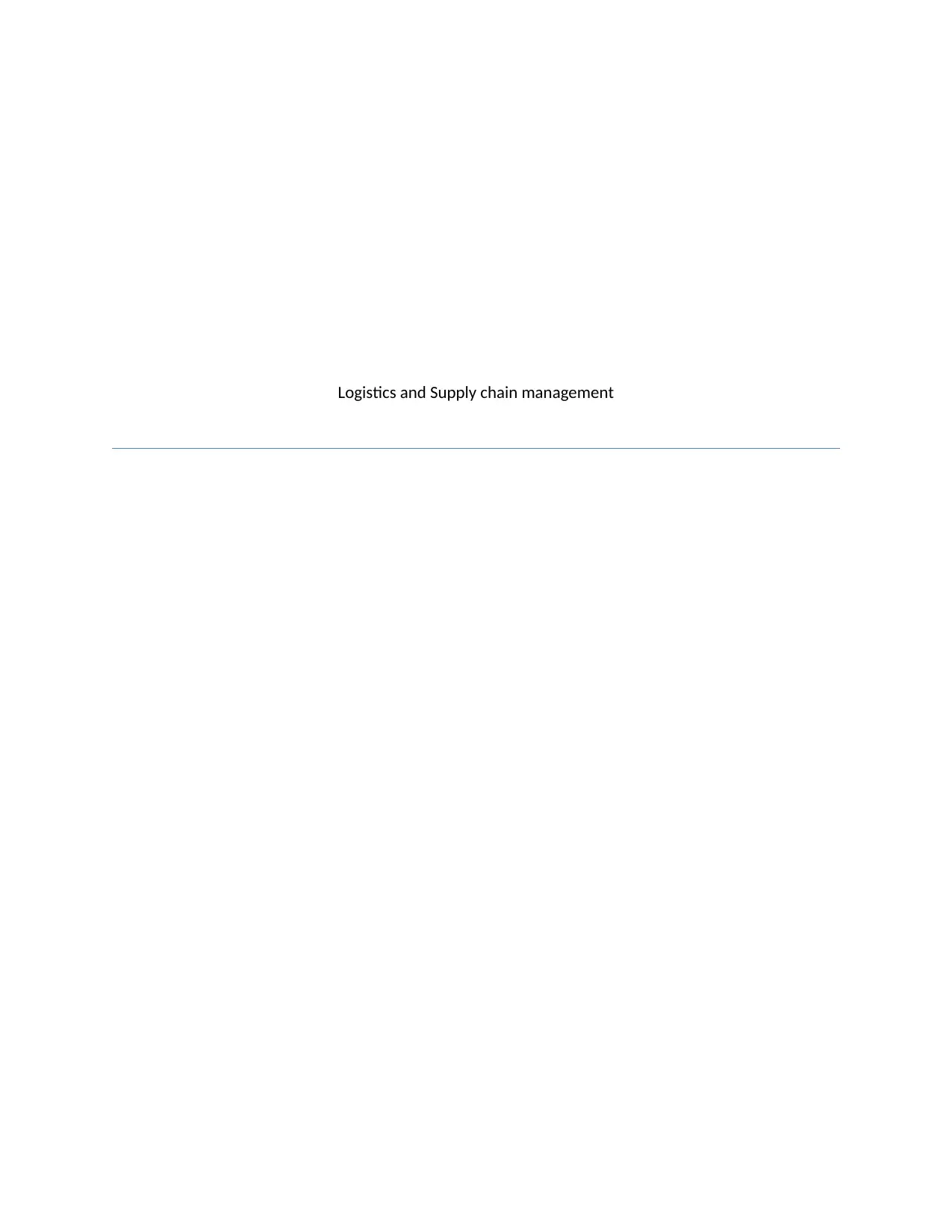
Logistics and Supply chain management
Paraphrase This Document
Need a fresh take? Get an instant paraphrase of this document with our AI Paraphraser
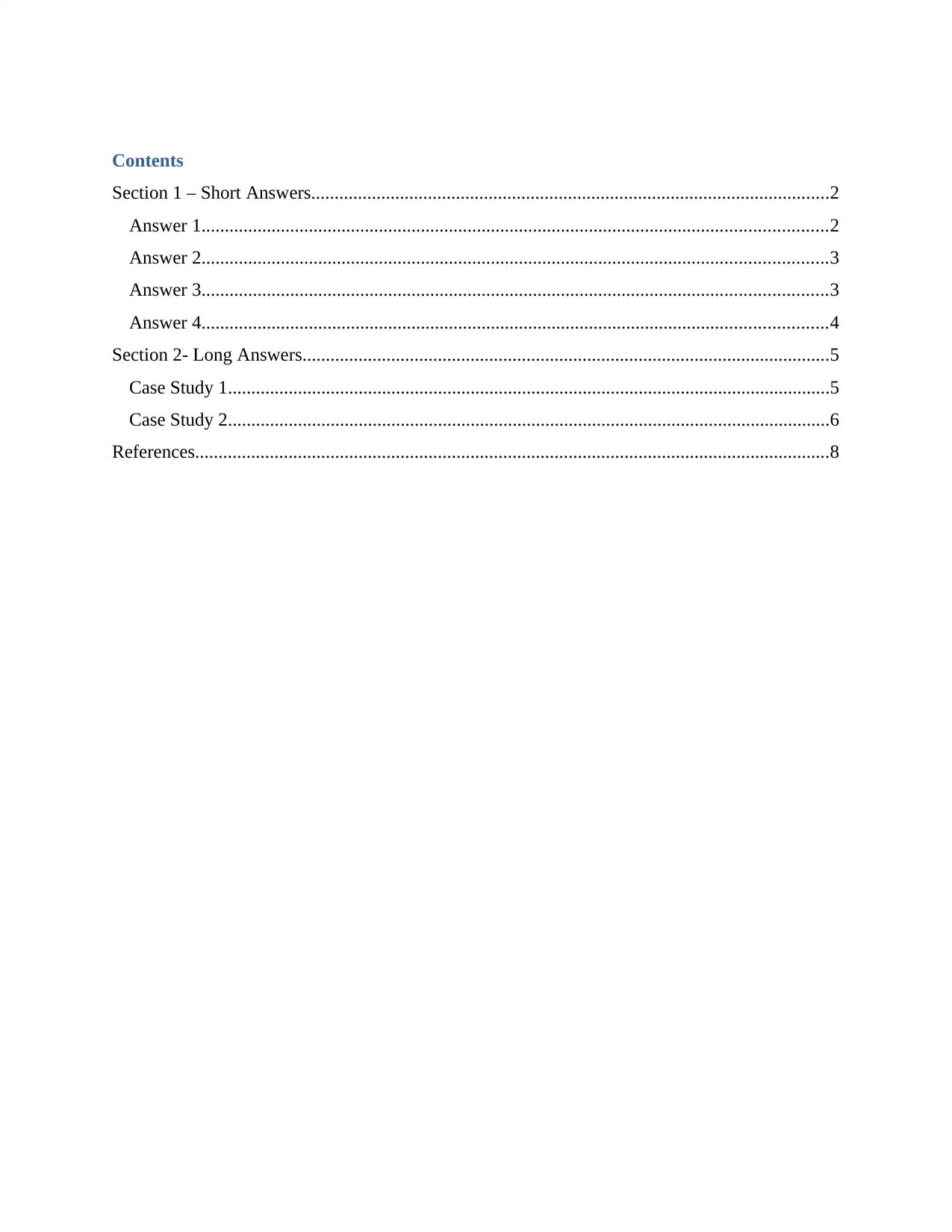
Contents
Section 1 – Short Answers...............................................................................................................2
Answer 1......................................................................................................................................2
Answer 2......................................................................................................................................3
Answer 3......................................................................................................................................3
Answer 4......................................................................................................................................4
Section 2- Long Answers.................................................................................................................5
Case Study 1.................................................................................................................................5
Case Study 2.................................................................................................................................6
References........................................................................................................................................8
Section 1 – Short Answers...............................................................................................................2
Answer 1......................................................................................................................................2
Answer 2......................................................................................................................................3
Answer 3......................................................................................................................................3
Answer 4......................................................................................................................................4
Section 2- Long Answers.................................................................................................................5
Case Study 1.................................................................................................................................5
Case Study 2.................................................................................................................................6
References........................................................................................................................................8
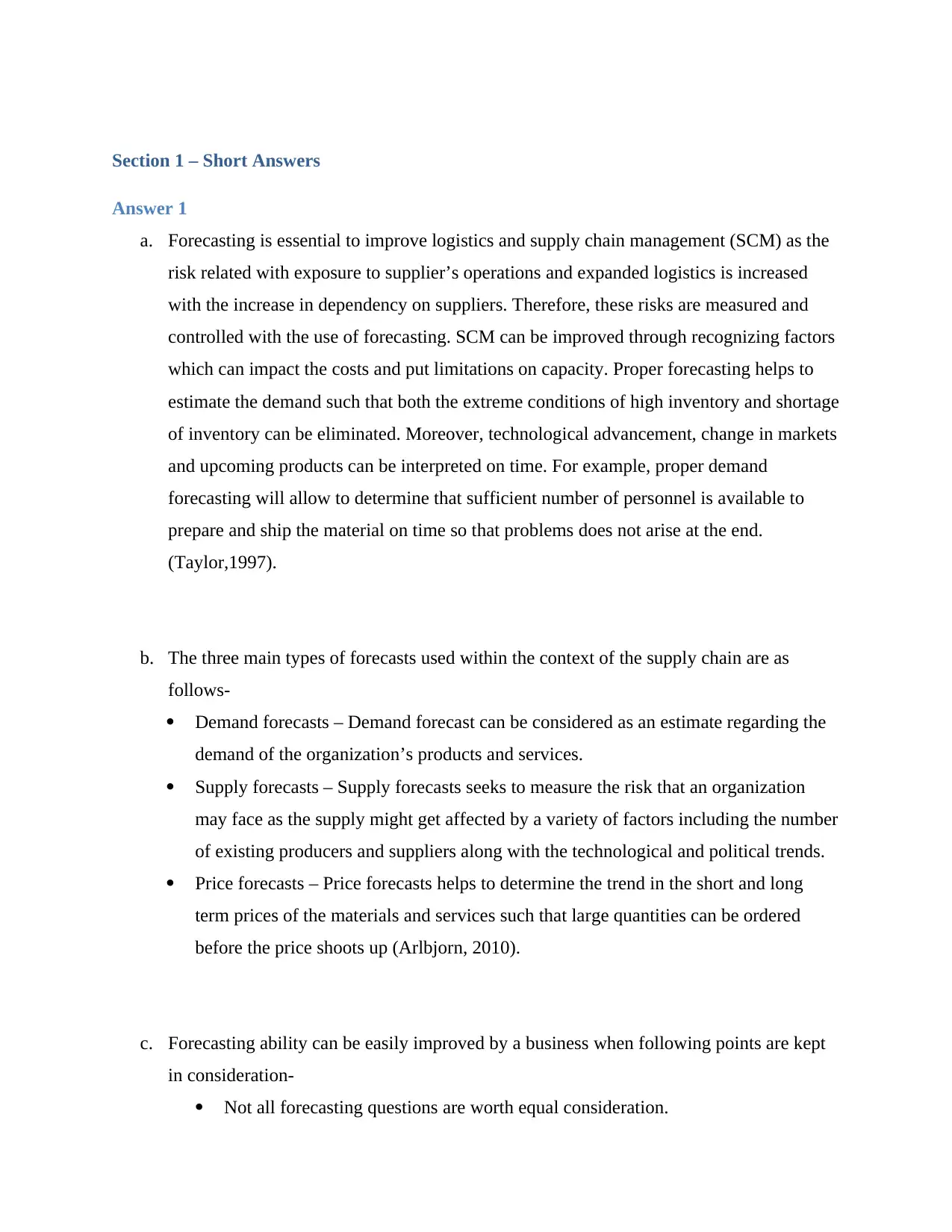
Section 1 – Short Answers
Answer 1
a. Forecasting is essential to improve logistics and supply chain management (SCM) as the
risk related with exposure to supplier’s operations and expanded logistics is increased
with the increase in dependency on suppliers. Therefore, these risks are measured and
controlled with the use of forecasting. SCM can be improved through recognizing factors
which can impact the costs and put limitations on capacity. Proper forecasting helps to
estimate the demand such that both the extreme conditions of high inventory and shortage
of inventory can be eliminated. Moreover, technological advancement, change in markets
and upcoming products can be interpreted on time. For example, proper demand
forecasting will allow to determine that sufficient number of personnel is available to
prepare and ship the material on time so that problems does not arise at the end.
(Taylor,1997).
b. The three main types of forecasts used within the context of the supply chain are as
follows-
Demand forecasts – Demand forecast can be considered as an estimate regarding the
demand of the organization’s products and services.
Supply forecasts – Supply forecasts seeks to measure the risk that an organization
may face as the supply might get affected by a variety of factors including the number
of existing producers and suppliers along with the technological and political trends.
Price forecasts – Price forecasts helps to determine the trend in the short and long
term prices of the materials and services such that large quantities can be ordered
before the price shoots up (Arlbjorn, 2010).
c. Forecasting ability can be easily improved by a business when following points are kept
in consideration-
Not all forecasting questions are worth equal consideration.
Answer 1
a. Forecasting is essential to improve logistics and supply chain management (SCM) as the
risk related with exposure to supplier’s operations and expanded logistics is increased
with the increase in dependency on suppliers. Therefore, these risks are measured and
controlled with the use of forecasting. SCM can be improved through recognizing factors
which can impact the costs and put limitations on capacity. Proper forecasting helps to
estimate the demand such that both the extreme conditions of high inventory and shortage
of inventory can be eliminated. Moreover, technological advancement, change in markets
and upcoming products can be interpreted on time. For example, proper demand
forecasting will allow to determine that sufficient number of personnel is available to
prepare and ship the material on time so that problems does not arise at the end.
(Taylor,1997).
b. The three main types of forecasts used within the context of the supply chain are as
follows-
Demand forecasts – Demand forecast can be considered as an estimate regarding the
demand of the organization’s products and services.
Supply forecasts – Supply forecasts seeks to measure the risk that an organization
may face as the supply might get affected by a variety of factors including the number
of existing producers and suppliers along with the technological and political trends.
Price forecasts – Price forecasts helps to determine the trend in the short and long
term prices of the materials and services such that large quantities can be ordered
before the price shoots up (Arlbjorn, 2010).
c. Forecasting ability can be easily improved by a business when following points are kept
in consideration-
Not all forecasting questions are worth equal consideration.
⊘ This is a preview!⊘
Do you want full access?
Subscribe today to unlock all pages.

Trusted by 1+ million students worldwide
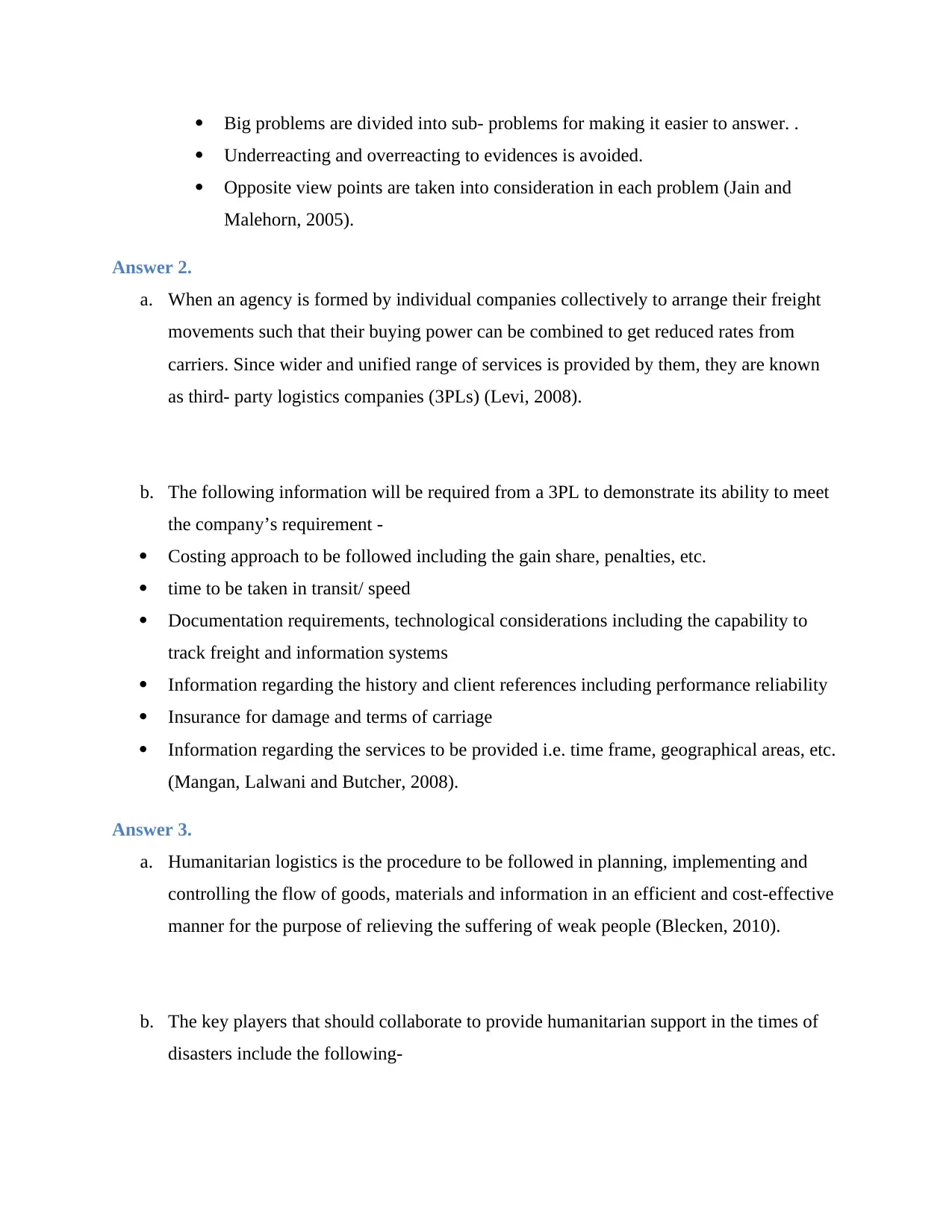
Big problems are divided into sub- problems for making it easier to answer. .
Underreacting and overreacting to evidences is avoided.
Opposite view points are taken into consideration in each problem (Jain and
Malehorn, 2005).
Answer 2.
a. When an agency is formed by individual companies collectively to arrange their freight
movements such that their buying power can be combined to get reduced rates from
carriers. Since wider and unified range of services is provided by them, they are known
as third- party logistics companies (3PLs) (Levi, 2008).
b. The following information will be required from a 3PL to demonstrate its ability to meet
the company’s requirement -
Costing approach to be followed including the gain share, penalties, etc.
time to be taken in transit/ speed
Documentation requirements, technological considerations including the capability to
track freight and information systems
Information regarding the history and client references including performance reliability
Insurance for damage and terms of carriage
Information regarding the services to be provided i.e. time frame, geographical areas, etc.
(Mangan, Lalwani and Butcher, 2008).
Answer 3.
a. Humanitarian logistics is the procedure to be followed in planning, implementing and
controlling the flow of goods, materials and information in an efficient and cost-effective
manner for the purpose of relieving the suffering of weak people (Blecken, 2010).
b. The key players that should collaborate to provide humanitarian support in the times of
disasters include the following-
Underreacting and overreacting to evidences is avoided.
Opposite view points are taken into consideration in each problem (Jain and
Malehorn, 2005).
Answer 2.
a. When an agency is formed by individual companies collectively to arrange their freight
movements such that their buying power can be combined to get reduced rates from
carriers. Since wider and unified range of services is provided by them, they are known
as third- party logistics companies (3PLs) (Levi, 2008).
b. The following information will be required from a 3PL to demonstrate its ability to meet
the company’s requirement -
Costing approach to be followed including the gain share, penalties, etc.
time to be taken in transit/ speed
Documentation requirements, technological considerations including the capability to
track freight and information systems
Information regarding the history and client references including performance reliability
Insurance for damage and terms of carriage
Information regarding the services to be provided i.e. time frame, geographical areas, etc.
(Mangan, Lalwani and Butcher, 2008).
Answer 3.
a. Humanitarian logistics is the procedure to be followed in planning, implementing and
controlling the flow of goods, materials and information in an efficient and cost-effective
manner for the purpose of relieving the suffering of weak people (Blecken, 2010).
b. The key players that should collaborate to provide humanitarian support in the times of
disasters include the following-
Paraphrase This Document
Need a fresh take? Get an instant paraphrase of this document with our AI Paraphraser
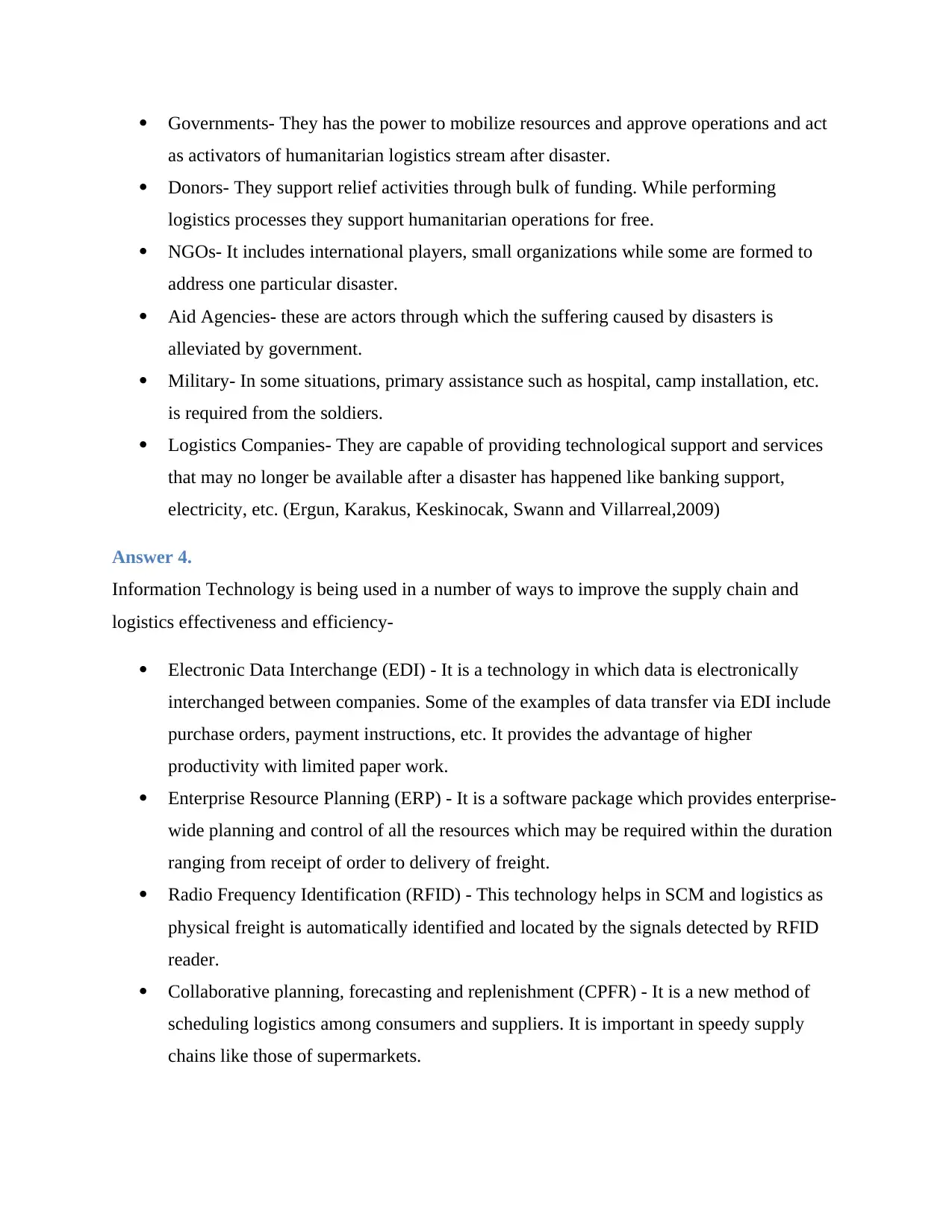
Governments- They has the power to mobilize resources and approve operations and act
as activators of humanitarian logistics stream after disaster.
Donors- They support relief activities through bulk of funding. While performing
logistics processes they support humanitarian operations for free.
NGOs- It includes international players, small organizations while some are formed to
address one particular disaster.
Aid Agencies- these are actors through which the suffering caused by disasters is
alleviated by government.
Military- In some situations, primary assistance such as hospital, camp installation, etc.
is required from the soldiers.
Logistics Companies- They are capable of providing technological support and services
that may no longer be available after a disaster has happened like banking support,
electricity, etc. (Ergun, Karakus, Keskinocak, Swann and Villarreal,2009)
Answer 4.
Information Technology is being used in a number of ways to improve the supply chain and
logistics effectiveness and efficiency-
Electronic Data Interchange (EDI) - It is a technology in which data is electronically
interchanged between companies. Some of the examples of data transfer via EDI include
purchase orders, payment instructions, etc. It provides the advantage of higher
productivity with limited paper work.
Enterprise Resource Planning (ERP) - It is a software package which provides enterprise-
wide planning and control of all the resources which may be required within the duration
ranging from receipt of order to delivery of freight.
Radio Frequency Identification (RFID) - This technology helps in SCM and logistics as
physical freight is automatically identified and located by the signals detected by RFID
reader.
Collaborative planning, forecasting and replenishment (CPFR) - It is a new method of
scheduling logistics among consumers and suppliers. It is important in speedy supply
chains like those of supermarkets.
as activators of humanitarian logistics stream after disaster.
Donors- They support relief activities through bulk of funding. While performing
logistics processes they support humanitarian operations for free.
NGOs- It includes international players, small organizations while some are formed to
address one particular disaster.
Aid Agencies- these are actors through which the suffering caused by disasters is
alleviated by government.
Military- In some situations, primary assistance such as hospital, camp installation, etc.
is required from the soldiers.
Logistics Companies- They are capable of providing technological support and services
that may no longer be available after a disaster has happened like banking support,
electricity, etc. (Ergun, Karakus, Keskinocak, Swann and Villarreal,2009)
Answer 4.
Information Technology is being used in a number of ways to improve the supply chain and
logistics effectiveness and efficiency-
Electronic Data Interchange (EDI) - It is a technology in which data is electronically
interchanged between companies. Some of the examples of data transfer via EDI include
purchase orders, payment instructions, etc. It provides the advantage of higher
productivity with limited paper work.
Enterprise Resource Planning (ERP) - It is a software package which provides enterprise-
wide planning and control of all the resources which may be required within the duration
ranging from receipt of order to delivery of freight.
Radio Frequency Identification (RFID) - This technology helps in SCM and logistics as
physical freight is automatically identified and located by the signals detected by RFID
reader.
Collaborative planning, forecasting and replenishment (CPFR) - It is a new method of
scheduling logistics among consumers and suppliers. It is important in speedy supply
chains like those of supermarkets.
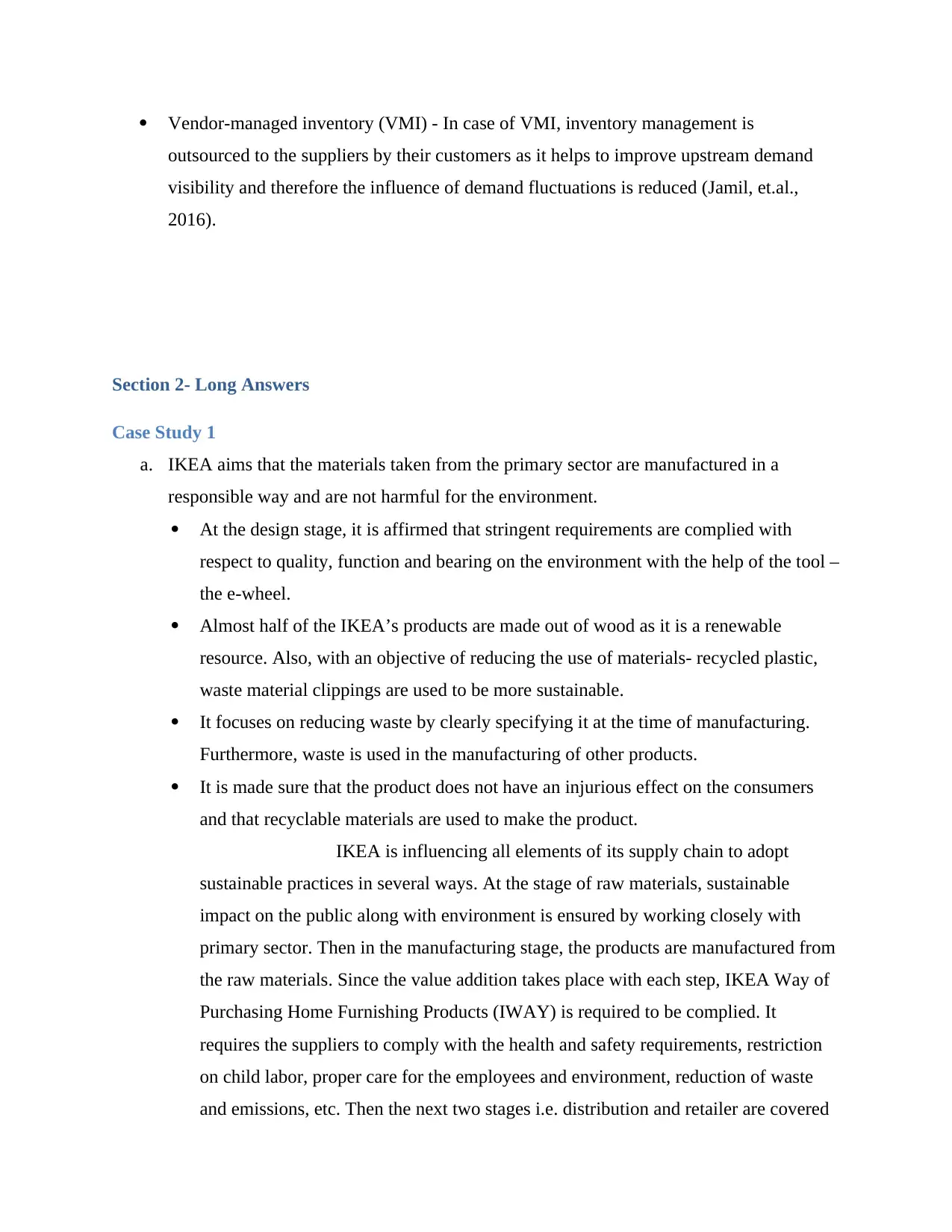
Vendor-managed inventory (VMI) - In case of VMI, inventory management is
outsourced to the suppliers by their customers as it helps to improve upstream demand
visibility and therefore the influence of demand fluctuations is reduced (Jamil, et.al.,
2016).
Section 2- Long Answers
Case Study 1
a. IKEA aims that the materials taken from the primary sector are manufactured in a
responsible way and are not harmful for the environment.
At the design stage, it is affirmed that stringent requirements are complied with
respect to quality, function and bearing on the environment with the help of the tool –
the e-wheel.
Almost half of the IKEA’s products are made out of wood as it is a renewable
resource. Also, with an objective of reducing the use of materials- recycled plastic,
waste material clippings are used to be more sustainable.
It focuses on reducing waste by clearly specifying it at the time of manufacturing.
Furthermore, waste is used in the manufacturing of other products.
It is made sure that the product does not have an injurious effect on the consumers
and that recyclable materials are used to make the product.
IKEA is influencing all elements of its supply chain to adopt
sustainable practices in several ways. At the stage of raw materials, sustainable
impact on the public along with environment is ensured by working closely with
primary sector. Then in the manufacturing stage, the products are manufactured from
the raw materials. Since the value addition takes place with each step, IKEA Way of
Purchasing Home Furnishing Products (IWAY) is required to be complied. It
requires the suppliers to comply with the health and safety requirements, restriction
on child labor, proper care for the employees and environment, reduction of waste
and emissions, etc. Then the next two stages i.e. distribution and retailer are covered
outsourced to the suppliers by their customers as it helps to improve upstream demand
visibility and therefore the influence of demand fluctuations is reduced (Jamil, et.al.,
2016).
Section 2- Long Answers
Case Study 1
a. IKEA aims that the materials taken from the primary sector are manufactured in a
responsible way and are not harmful for the environment.
At the design stage, it is affirmed that stringent requirements are complied with
respect to quality, function and bearing on the environment with the help of the tool –
the e-wheel.
Almost half of the IKEA’s products are made out of wood as it is a renewable
resource. Also, with an objective of reducing the use of materials- recycled plastic,
waste material clippings are used to be more sustainable.
It focuses on reducing waste by clearly specifying it at the time of manufacturing.
Furthermore, waste is used in the manufacturing of other products.
It is made sure that the product does not have an injurious effect on the consumers
and that recyclable materials are used to make the product.
IKEA is influencing all elements of its supply chain to adopt
sustainable practices in several ways. At the stage of raw materials, sustainable
impact on the public along with environment is ensured by working closely with
primary sector. Then in the manufacturing stage, the products are manufactured from
the raw materials. Since the value addition takes place with each step, IKEA Way of
Purchasing Home Furnishing Products (IWAY) is required to be complied. It
requires the suppliers to comply with the health and safety requirements, restriction
on child labor, proper care for the employees and environment, reduction of waste
and emissions, etc. Then the next two stages i.e. distribution and retailer are covered
⊘ This is a preview!⊘
Do you want full access?
Subscribe today to unlock all pages.

Trusted by 1+ million students worldwide
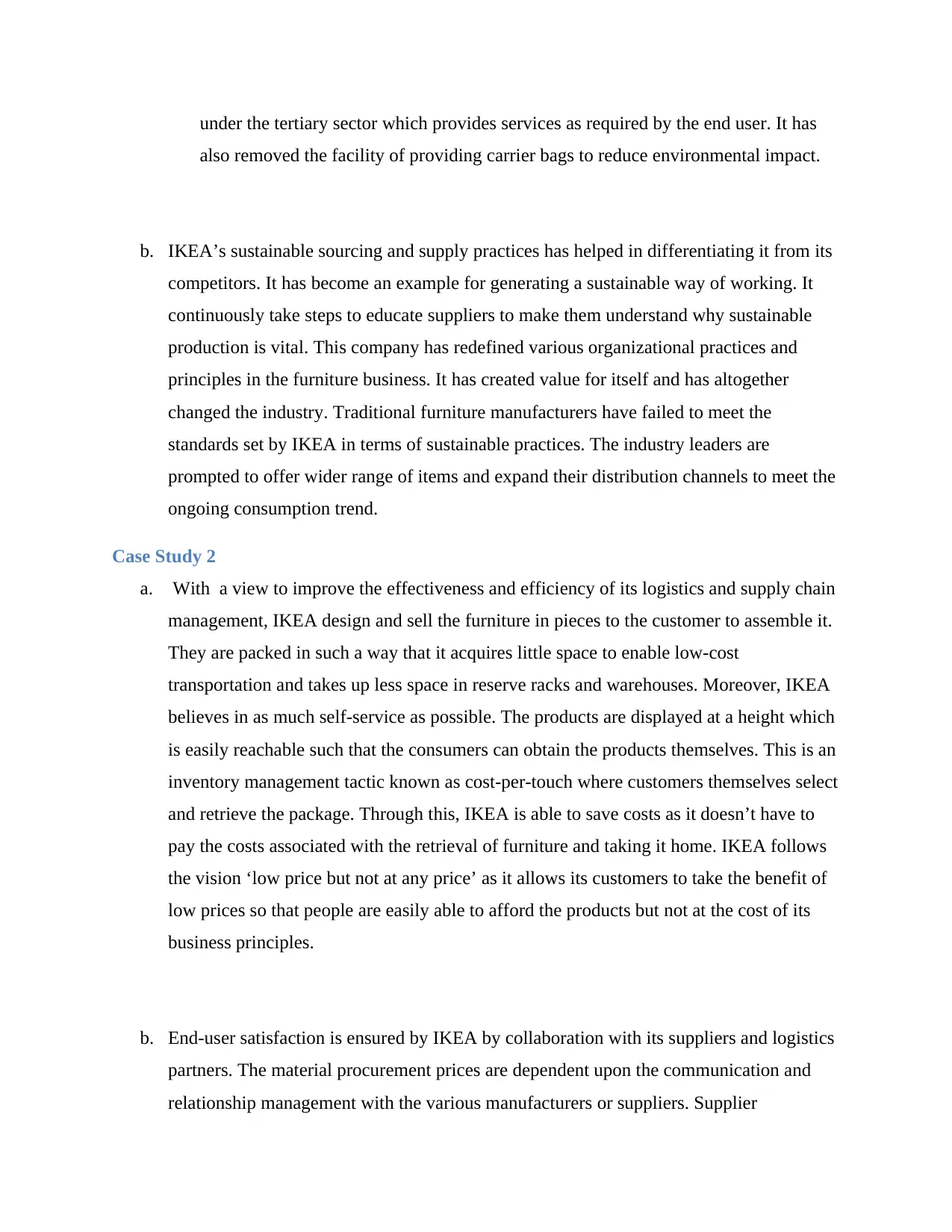
under the tertiary sector which provides services as required by the end user. It has
also removed the facility of providing carrier bags to reduce environmental impact.
b. IKEA’s sustainable sourcing and supply practices has helped in differentiating it from its
competitors. It has become an example for generating a sustainable way of working. It
continuously take steps to educate suppliers to make them understand why sustainable
production is vital. This company has redefined various organizational practices and
principles in the furniture business. It has created value for itself and has altogether
changed the industry. Traditional furniture manufacturers have failed to meet the
standards set by IKEA in terms of sustainable practices. The industry leaders are
prompted to offer wider range of items and expand their distribution channels to meet the
ongoing consumption trend.
Case Study 2
a. With a view to improve the effectiveness and efficiency of its logistics and supply chain
management, IKEA design and sell the furniture in pieces to the customer to assemble it.
They are packed in such a way that it acquires little space to enable low-cost
transportation and takes up less space in reserve racks and warehouses. Moreover, IKEA
believes in as much self-service as possible. The products are displayed at a height which
is easily reachable such that the consumers can obtain the products themselves. This is an
inventory management tactic known as cost-per-touch where customers themselves select
and retrieve the package. Through this, IKEA is able to save costs as it doesn’t have to
pay the costs associated with the retrieval of furniture and taking it home. IKEA follows
the vision ‘low price but not at any price’ as it allows its customers to take the benefit of
low prices so that people are easily able to afford the products but not at the cost of its
business principles.
b. End-user satisfaction is ensured by IKEA by collaboration with its suppliers and logistics
partners. The material procurement prices are dependent upon the communication and
relationship management with the various manufacturers or suppliers. Supplier
also removed the facility of providing carrier bags to reduce environmental impact.
b. IKEA’s sustainable sourcing and supply practices has helped in differentiating it from its
competitors. It has become an example for generating a sustainable way of working. It
continuously take steps to educate suppliers to make them understand why sustainable
production is vital. This company has redefined various organizational practices and
principles in the furniture business. It has created value for itself and has altogether
changed the industry. Traditional furniture manufacturers have failed to meet the
standards set by IKEA in terms of sustainable practices. The industry leaders are
prompted to offer wider range of items and expand their distribution channels to meet the
ongoing consumption trend.
Case Study 2
a. With a view to improve the effectiveness and efficiency of its logistics and supply chain
management, IKEA design and sell the furniture in pieces to the customer to assemble it.
They are packed in such a way that it acquires little space to enable low-cost
transportation and takes up less space in reserve racks and warehouses. Moreover, IKEA
believes in as much self-service as possible. The products are displayed at a height which
is easily reachable such that the consumers can obtain the products themselves. This is an
inventory management tactic known as cost-per-touch where customers themselves select
and retrieve the package. Through this, IKEA is able to save costs as it doesn’t have to
pay the costs associated with the retrieval of furniture and taking it home. IKEA follows
the vision ‘low price but not at any price’ as it allows its customers to take the benefit of
low prices so that people are easily able to afford the products but not at the cost of its
business principles.
b. End-user satisfaction is ensured by IKEA by collaboration with its suppliers and logistics
partners. The material procurement prices are dependent upon the communication and
relationship management with the various manufacturers or suppliers. Supplier
Paraphrase This Document
Need a fresh take? Get an instant paraphrase of this document with our AI Paraphraser
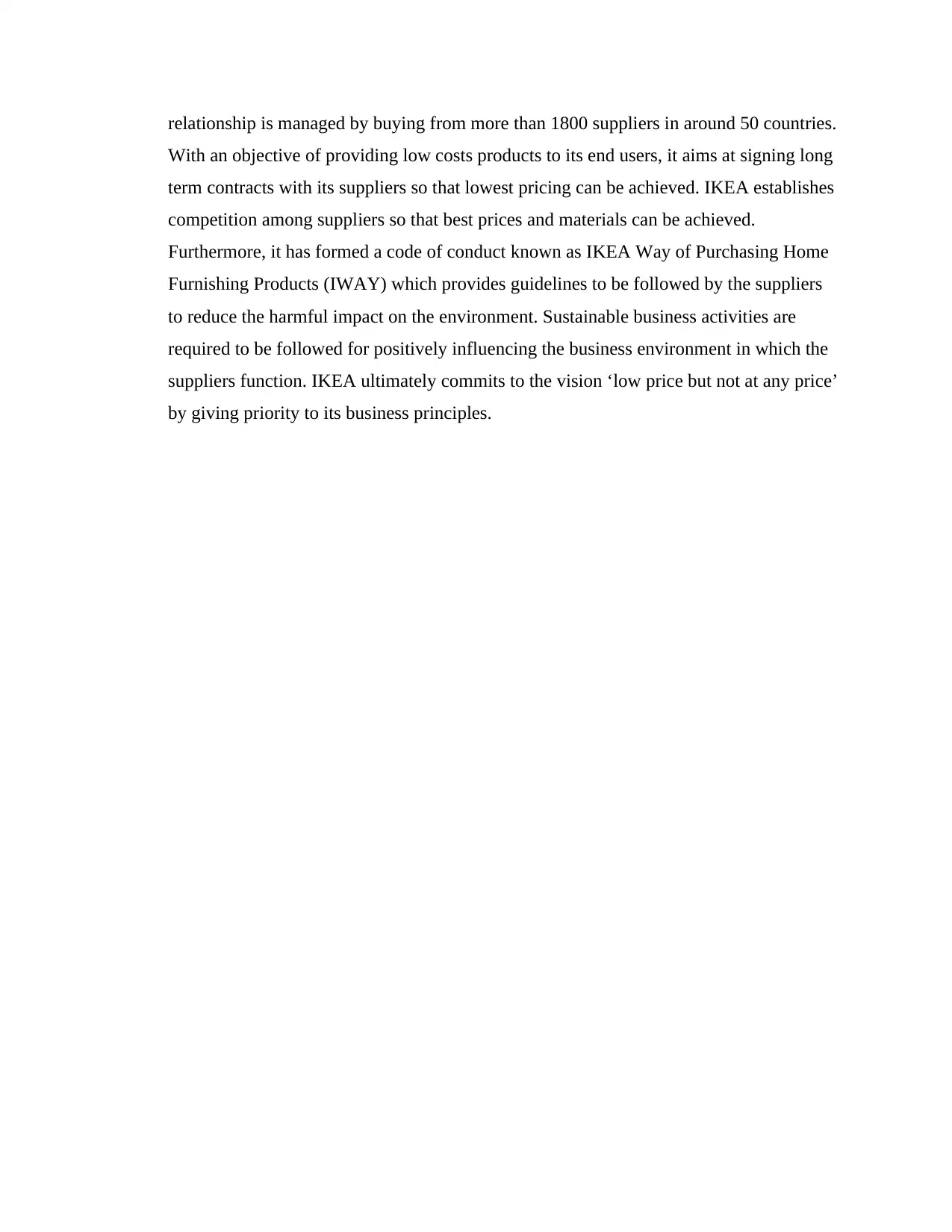
relationship is managed by buying from more than 1800 suppliers in around 50 countries.
With an objective of providing low costs products to its end users, it aims at signing long
term contracts with its suppliers so that lowest pricing can be achieved. IKEA establishes
competition among suppliers so that best prices and materials can be achieved.
Furthermore, it has formed a code of conduct known as IKEA Way of Purchasing Home
Furnishing Products (IWAY) which provides guidelines to be followed by the suppliers
to reduce the harmful impact on the environment. Sustainable business activities are
required to be followed for positively influencing the business environment in which the
suppliers function. IKEA ultimately commits to the vision ‘low price but not at any price’
by giving priority to its business principles.
With an objective of providing low costs products to its end users, it aims at signing long
term contracts with its suppliers so that lowest pricing can be achieved. IKEA establishes
competition among suppliers so that best prices and materials can be achieved.
Furthermore, it has formed a code of conduct known as IKEA Way of Purchasing Home
Furnishing Products (IWAY) which provides guidelines to be followed by the suppliers
to reduce the harmful impact on the environment. Sustainable business activities are
required to be followed for positively influencing the business environment in which the
suppliers function. IKEA ultimately commits to the vision ‘low price but not at any price’
by giving priority to its business principles.
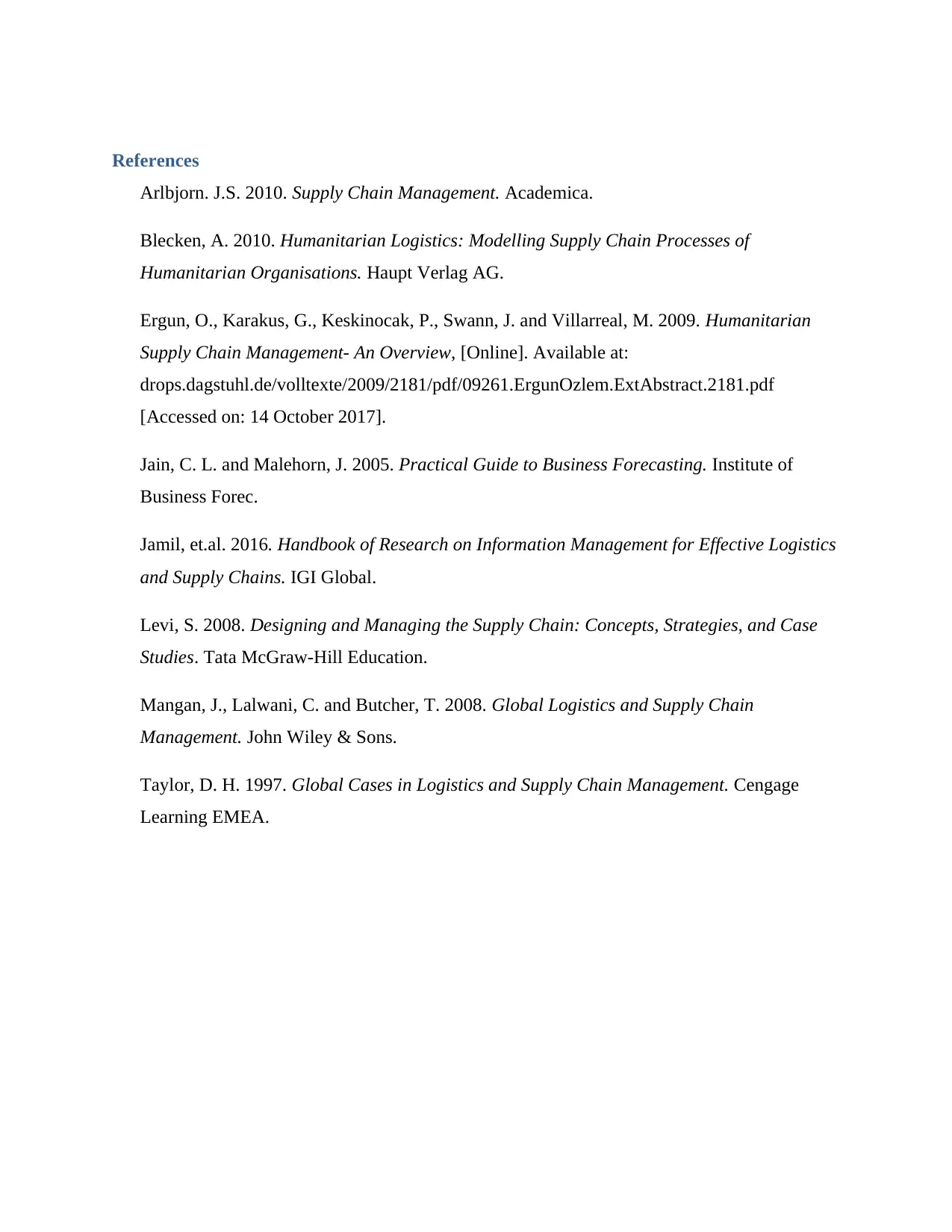
References
Arlbjorn. J.S. 2010. Supply Chain Management. Academica.
Blecken, A. 2010. Humanitarian Logistics: Modelling Supply Chain Processes of
Humanitarian Organisations. Haupt Verlag AG.
Ergun, O., Karakus, G., Keskinocak, P., Swann, J. and Villarreal, M. 2009. Humanitarian
Supply Chain Management- An Overview, [Online]. Available at:
drops.dagstuhl.de/volltexte/2009/2181/pdf/09261.ErgunOzlem.ExtAbstract.2181.pdf
[Accessed on: 14 October 2017].
Jain, C. L. and Malehorn, J. 2005. Practical Guide to Business Forecasting. Institute of
Business Forec.
Jamil, et.al. 2016. Handbook of Research on Information Management for Effective Logistics
and Supply Chains. IGI Global.
Levi, S. 2008. Designing and Managing the Supply Chain: Concepts, Strategies, and Case
Studies. Tata McGraw-Hill Education.
Mangan, J., Lalwani, C. and Butcher, T. 2008. Global Logistics and Supply Chain
Management. John Wiley & Sons.
Taylor, D. H. 1997. Global Cases in Logistics and Supply Chain Management. Cengage
Learning EMEA.
Arlbjorn. J.S. 2010. Supply Chain Management. Academica.
Blecken, A. 2010. Humanitarian Logistics: Modelling Supply Chain Processes of
Humanitarian Organisations. Haupt Verlag AG.
Ergun, O., Karakus, G., Keskinocak, P., Swann, J. and Villarreal, M. 2009. Humanitarian
Supply Chain Management- An Overview, [Online]. Available at:
drops.dagstuhl.de/volltexte/2009/2181/pdf/09261.ErgunOzlem.ExtAbstract.2181.pdf
[Accessed on: 14 October 2017].
Jain, C. L. and Malehorn, J. 2005. Practical Guide to Business Forecasting. Institute of
Business Forec.
Jamil, et.al. 2016. Handbook of Research on Information Management for Effective Logistics
and Supply Chains. IGI Global.
Levi, S. 2008. Designing and Managing the Supply Chain: Concepts, Strategies, and Case
Studies. Tata McGraw-Hill Education.
Mangan, J., Lalwani, C. and Butcher, T. 2008. Global Logistics and Supply Chain
Management. John Wiley & Sons.
Taylor, D. H. 1997. Global Cases in Logistics and Supply Chain Management. Cengage
Learning EMEA.
⊘ This is a preview!⊘
Do you want full access?
Subscribe today to unlock all pages.

Trusted by 1+ million students worldwide
1 out of 9
Related Documents
Your All-in-One AI-Powered Toolkit for Academic Success.
+13062052269
info@desklib.com
Available 24*7 on WhatsApp / Email
![[object Object]](/_next/static/media/star-bottom.7253800d.svg)
Unlock your academic potential
Copyright © 2020–2025 A2Z Services. All Rights Reserved. Developed and managed by ZUCOL.





